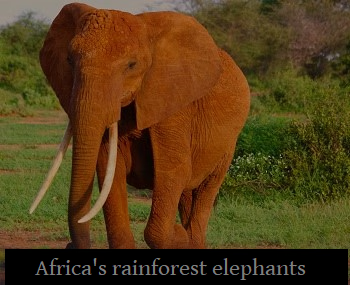Endangered African Rainforest Elephants
African forest elephants live in the rainforests for cental Africa. New studies reveal interesting facts about forest elephants. African forest elephants are shorter, smaller and rarely seen by humans. They are endangered because of habitat loss and poaching.

For a long time, two types of elephants were recognised - Asian elephants and African elephants. A third type was recently discovered, African forest elephants. They are found in Central Africa, in the dense African rainforests.
Forest elephant vs Bush elephant
Common African elephants are called Bush elephants or grassland elephants. They live in open grasslands of Africa. They roam the savannah in big groups. When it comes to protecting their herd, these huge elephants are aggressive. They take on tigers and lions to protect their calves. But the African forest elephants are smaller in size. They live hidden in the rain forest. It is rare to see them in open clearings.
Why are forest elephants a keystone species
Forest elephants are important to the rainforest ecosystem. They eat fruits, barks and tubers. They cannot digest seeds. It comes out in their dung. Dung acts as a manure helping
seeds sprout in to new plants and grow into healthy trees. They are called mega-gardeners of the African rain forest.
Dense rainforests have less sun light reaching the forest floor. When elephants walk, they trample tall grass and bushes to clear the way for smaller grass eating animals. They make the forest livable and safe for
insects, reptiles and animals.
Different species of African elephants
DNA studies started in 1980 identified major differences between forest elephants and bush elephants of Africa. Many long years of research confirmed African forest elephants to be a separate species.
Africa's bush elephants and forest elephants split from a common ancestor 2 million years ago and have evolved separately after that.
In 2021, IUCN confirmed African Forest Elephants as a distinct type
of elephant species and labelled them "critically endangered".
Elephant adaptations
Elephants live in tropical regions with high temperatures. Big flappy ears and wrinkled skin helps them cool down. Their tusks are adaptations to dig the ground for food and water. Ivory hunting has long been a threat to elephants. Female elephants in Asia are born without tusks. It helps them survive poaching. In Africa's rain forest, elusive and shy forest elephants show violent behaviours when they see humans. Memories of their loved ones hunted down by poachers makes them aggressive to humans.
Why African forest elephant is endangered
Tusks are incisor teeth protruding out in elephants. It is an adaptation to dig the ground in search of tubers and underground water springs. African forest elephants have straight,long tusks hard enough for carving. There is high demand for forest elephant tusks as it is perfect for carving big artefacts.
Conservation efforts
Historically, items like piano keys, chess sets, jewellery were made of ivory. Nowadays, laws in many countries declare ivory artefacts illegal.
Instead synthetic materials are used. There still remain few countries where ivory is a symbol of wealth. Demand for ivory in these countries drives illegal hunting (called poaching) of elephants.
We have lost 86% of forest elephants in the last 30 years.
Reproduction in African forest elephants
Female forest elephants begin breeding late at 23 years, while bush elephants begin breeding as early as 12 years. Once they become adults and start reproducing, female forest elephants can reproduce once every 5 or 6 years only. Bush elephants can reproduce once every 3 years. This means increasing forest elephant numbers takes longer than increasing bush elephant numbers. In 2021, African forest elephants were labelled "critically endangered".
